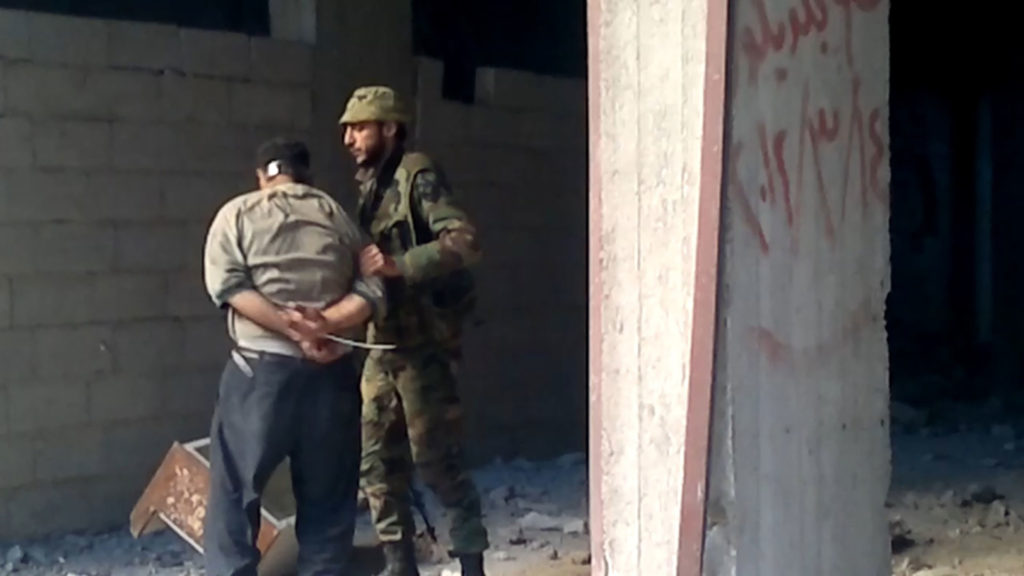The videos exposed some of the crimes committed by the Syrian Bashar Al Assad regime.
‘Tadamon Massacre’ has topped Twitter trends in Qatar following local and global outrage in response to leaked footage of the mass executions of innocent Syrians by the Bashar Al Assad regime.
Dating back to April 2013, the footage was released by The Guardian, showing at least 41 Syrian and Palestinian civilians being executed and tortured in Tadamon, near Syria’s capital Damascus.
The total victims of the massacre was 288, including 12 children.
The footage was initially recorded and leaked by a loyalist militiaman, who was recruited at the time of the massacre, to opposition activist in France. It was then sent to two researchers, Annsar Shahhoud and Professor Uğur Ümit Üngör at the University of Amsterdam’s Holocaust and Genocide Center.
Clips showed blindfolded victims whose hands were tied behind their backs running as they were being shot by Assad’s forces into a mass grave. The killers then proceeded to pour fuel on the victims piled up in the pit before burning them.
The harrowing executions committed by the Assad regime sparked global and local outrage on social media.
“The horrific crime #Tadamon_Massacre that Bashar’s clients carried out in 2013 is now revealed is only a drop in a sea of heinous crimes committed by the Assad regime against the Syrian people, especially since the 2011 revolution,” tweeted Jaber Al Harmi, a prominent Qatari journalist.
Al Harmi also said that Arab countries currently seeking to re-instate Syria’s membership in the Arab League should see the footage.
Syria’s membership was suspended at the height of the Arab Spring in 2011 after the Assad regime failed to meet the deadline given by members of the bloc to end its crackdowns on peaceful protesters.
Qatar has repeatedly refused to normalise with the Assad regime and was the first Arab country to close its embassy in Damascus. The Gulf state also refuses to return Syria to the Arab League.
“The new scenes from #Tadamon_Massacre are shocking. Al-Assad and his regime have preceded ISIS and all the extremists in the scale of crime and the shedding of innocent blood,” tweeted Al Jazeera Arabic journalist Mohamed Alzanin.
Other social media users said that the leaked footage is another evidence that exposed ongoing crimes committed by the Assad regime.
“The #Tadamon_Massacre recordings remind the world for the 1000th time of what the oppressed Syrian people went through. Remember the justice of the revolution against the Assad regime, the courage of those who revolted against it,” tweeted Qatar-based academic Baraa Nezar Raya.
Social media user Haneen Al Hiraky said that “covering up crimes and preserving evidence is no less heinous than what the offender did.”
“Rather, it is a moral participation in the crime,” she added.
Salem Al-Meslet, President of Syrian National Coalition of the Revolutionary Forces and opposition, said that the massacre “is one of thousands of similar hidden massacres” by the Assad regime.
The Syrian official noted that once the other crimes are revealed, they “will account for the fate of tens of thousands of Syrians who are forcibly disappeared or missing.”
The US State Department condemned the crimes in the video, describing the killings as an ‘apparent massacre’.
“Accountability and justice for the crimes, violations, and abuses committed against Syrians are essential to a stable, just, and enduring peace in Syria and the region,” said US State Department Spokesperson Ned Price.
During the same year as the Tadamon Massacre, the notorious Ghouta chemical attack massacre took place on 21 August, which human rights groups report killed at least 1500 people.
Some of the alleged killers
The investigations by the two researches Annsar Shahhoud and Prof Uğur Ümit Üngör, found that the perpetrators were under branch 227 of the Syria’s notorious military intelligence service.
Following in depth research, that included tracing back some of the perpetrators on social media, they dentified one of the leading military faces in the footage as Amjad Youssef.
According to The Guardian report, Youssef admitted to the killings to Annsar, who posed as Anna on Facebook for four years in an effort to find the killers. The researcher had spoken to 200 regime officials by then.
“I’m proud of what I did,” wrote Youssuf to Annsar upon being confronted with the video evidence and threatened to kill her and her family.
Ongoing human rights violations
Peaceful protests in Syria in 2011 aimed at toppling the Assad regime turned violent once his forces began cracking down on opponents. This was followed with an ongoing war that has continued to displace Syrians.
According to the UN, there are 5,724,230 Syrian refugees as of 31 March. The total refugees and internally displaced persons expected to flee their homes is expected to rise due to the ongoing war.
The crimes committed by the Assad regime have also left millions unable to safely return to their homes.
One crime previously exposed was the torture of Syrians detained in Assad’s prisoners. The horrifying methods of torture used by Assad were seen in 2014 through the Caesar photographs, which were leaked by a defected Syrian military photographer.
More than 28,000 photos of deaths under government custody displayed the cruelty of the regime. The code name of the former military photographer was behind the 2020 “Caesar Act”.
The act is a set of sanctions imposed by the US that target businesses, individuals, and government institutions that deal with the Syrian administration.
Courtrooms across Europe, including Germany, have begun trials against former Assad regime officers over the past year. The court hearings provided hope that some level of accountability of the atrocities committed in Syria will be achieved.







